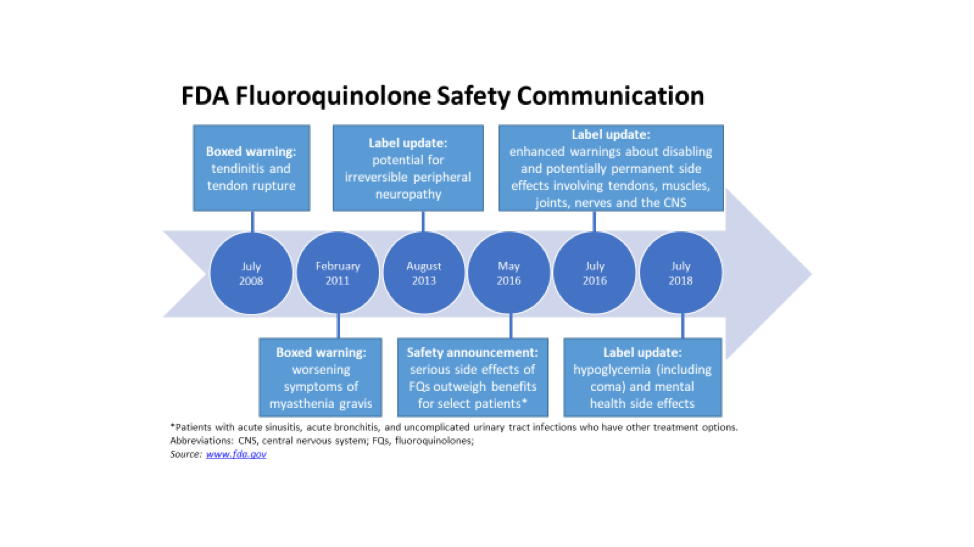Fluoroquinolone Antibiotics: More Recommendations for Prudent Use
Despite concerning findings and warnings, fluoroquinolones have remained one of the world’s most commonly prescribed antibiotic classes, with the United States accounting for more than 32 million prescriptions in 2015 alone.
The safety committee of the European Medicines Agency (EMA)—the Pharmacovigilance Risk Assessment Committee (PRAC)—has recommended restricting the use of fluoroquinolone and quinolone antibiotics following a review of safety issues reported with these medicines.
The PRAC recommended that fluoroquinolone antibiotics should not be used for the following:
- To treat self-resolving infections (such as throat infections)
- To prevent traveler’s diarrhea or recurring lower urinary tract infections
- To treat patients who have previously had serious adverse effects from a fluoroquinolone or quinolone antibiotic
- To treat mild or moderately severe infections unless other antibacterial medicines commonly recommended for these infections cannot be used
With the release, the EMA joins other regulatory agencies, such as the US Food and Drug Administration (FDA) and Health Canada, that have warned doctors and the public about the risk of disabling and persistent serious adverse reactions. The FDA has issued a series of safety alerts regarding the use of fluoroquinolone antibiotics (see Figure). The first boxed warning for fluoroquinolones was added in July 2008 for the increased risk of tendinitis and tendon rupture, and the FDA has since added another boxed warning and several label updates.

Numerous studies have raised safety concerns about the association between fluoroquinolone treatment and rare but serious and debilitating adverse events in muscles, joints, and the central nervous system. Moreover, the use of fluoroquinolones has been associated with increased rates of Clostridioides difficile infection and resistance among Staphylococcus aureus and gram-negative organisms.
Despite these concerning findings and warnings, fluoroquinolones have remained one of the world’s most commonly prescribed antibiotic classes, with the United States accounting for more than 32 million fluoroquinolone prescriptions in 2015 alone.
Limiting unnecessary fluoroquinolone use has become an area of focused effort for many antimicrobial stewardship programs. For example, antimicrobial stewardship initiatives to reduce fluoroquinolone use were the topic of numerous poster abstracts at the 2018 IDWeek Meeting. The conference featured myriad presentations on a variety of strategies (treatment pathways, provider education, selective/suppressed antimicrobial susceptibility reporting), and most were able to show significant reductions in overall fluoroquinolone use.
Fluoroquinolones remain important antibiotics for treating serious, life-threatening bacterial infections and are safe for most people. Notably, fluoroquinolones are one of the few oral antibiotics with activity against Pseudomonas species, making them attractive therapeutic options for affected patients who do not require intravenous administration of their antibiotic therapy or are not suitable candidates for central venous access.
PRAC also recommended that fluoroquinolones be used with caution in patient populations who are at higher risk of tendon injury caused by fluoroquinolones (eg, elderly transplant patients and those who are being treated with a systemic corticosteroid).
Furthermore, PRAC recommended that health care professionals advise patients to stop treatment with a fluoroquinolone antibiotic at the first sign of an adverse effect involving muscles, tendons or bones, or the central nervous system.
The PRAC review was initiated at the request of German Federal Institute for Drugs and Medical Devices in February 2017 to evaluate the safety of fluoroquinolones. The PRAC held a public hearing on the topic in June 2018 to document the views of patients and the public on the persistence of adverse effects reported with this group of medicines. The PRAC recommendations will now be sent to EMA’s Committee for Medicinal Products for Human Use, which will adopt the agency’s final opinion.
Disclosures: Dr. MacVane is the clinical Studies director at Accelerate Diagnostics, Inc.
